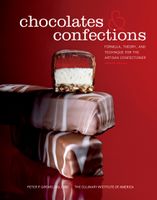Advertisement
Repairing Separated Ganache
By Peter Greweling and Culinary Institute of America
Published 2007
- Warm the ganache to 32° to 34°C/90° to 94°F, then stir it to re-emulsify it and melt most of the fat crystals. Finally, agitate it to disperse the fat droplets. When warming the ganache, take care not to heat it above 34°C/94°F, in order to preserve the existing Form-V cocoa butter crystals so that the ganache will set properly. (See Crystallization of Ganache.) Agitation may be accomplished by hand, with a spatula or whisk, or with a machine, such as an immersion blender or food processor. If the ganache is not excessively high in fat, warming and stirring will re-emulsify it. If this step fails to repair the ganache, it is too rich in fat and will require the addition of moisture to allow the fat to disperse.
Extra liquid should be added to a ganache only when step 1 fails. With the ganache between 32° and 34°C/90° and 94°F, add a minimum amount of warm liquid while stirring. Adding liquid affords space to fat droplets that are packed too closely together and so could coalesce. Several different liquids are effective in repairing ganache in this manner; these include spirits, milk, glucose syrup, and even water. Cream is not a good choice for this procedure because it contains a high percentage of fat and thus contributes to the fat phase, somewhat defeating the purpose of adding liquid. Adding water or milk will increase the ganache’s water activity and limit its shelf stability, so they are not good choices for repairing ganache if shelf life is a concern. Neither spirits nor syrup contains fat, so they have a less detrimental effect on shelf stability and are the best choices for the procedure. Care must always be taken not to add excess liquid to ganache, which will soften it, making it difficult to handle. Adding the minimum amount of liquid required to re-emulsify the ganache is always the goal.
A ganache that requires the addition of liquid to re-emulsify it is too high in fat. Its formula should therefore be adjusted for future batches. The goal of adjusting such a formula is to decrease slightly the percentage of the fat phase compared to the water phase in order to allow the dispersal of the fat droplets. This can be accomplished through a number of changes, including using a lower-fat chocolate or cream, replacing a portion of the cream with milk, reducing or eliminating butter from the formula, increasing the liquid flavoring, and reducing the amount of chocolate. In all cases, the goal is to make a ganache with a slightly lower ratio of fat to liquid. Adjustments to the formula must be made incrementally, and only experimentation will reveal when the ganache contains just enough moisture not to separate but not so much that it is too soft to handle and has a poor shelf life.



